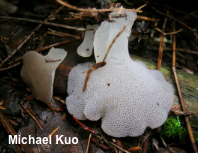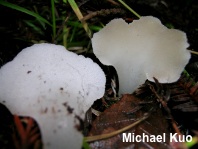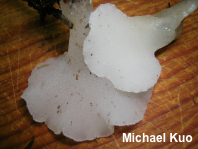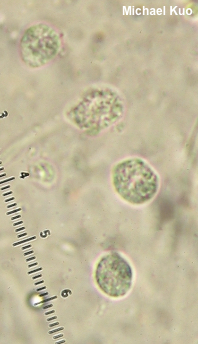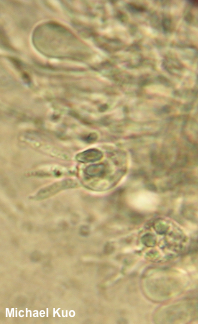| Major Groups > Toothed Mushrooms / Jelly Fungi > Pseudohydnum gelatinosum |

|
Pseudohydnum gelatinosum [ Basidiomycota > Auriculariales > (?)-aceae > Pseudohydnum . . . ] by Michael Kuo Steve Martin used to claim that he shaved his tongue—which must mean that he had Pseudohydnum gelatinosum in his mouth, since this mushroom looks for all the world like a tiny, gelatinous tongue in need of a shave; its underside is covered with tiny spines. It is both a jelly fungus and a toothed mushroom, found on conifer wood or on woody debris in conifer forests. This fungus, as it is currently defined, has an incredibly wide distribution; it is found almost across the globe, in a diverse array of ecosystems. Since several features, including the color of the cap and spore size, appear to vary considerably, one wonders whether more than one phylogenetic species might be involved. Description: Ecology: Saprobic on the wood or woody debris of conifers, causing a white rot; sometimes growing from standing trees; growing alone, scattered, or gregariously; late summer and fall, or fall and winter in warmer climates; originally described from Slovenia; widely distributed in Europe, North America, Central America, the Caribbean, South America, Asia, and Oceania. The illustrated and described collections are from California and Michigan. Cap: 2.5–5.5 cm across; tongue-shaped or kidney-shaped; broadly convex or flat; gelatinous but not slimy to the touch; smooth or finely fuzzy; translucent white to grayish, brown, or fairly dark brown; the margin tucked under when young. Undersurface: Running down the stem; spines to 2 mm long; translucent white or pale grayish. Stem: To 3 cm long; either lateral and stubby (when specimens are growing from the sides of logs) or well-developed and vertical (when specimens are growing from the tops of logs or from terrestrial woody debris); gelatinous; smooth; colored like the cap or paler. Flesh: Translucent; gelatinous. Odor: Not distinctive. Spore Print: White. Microscopic Features: Spores 6–7 x 5–7 µm; subglobose to very broadly ellipsoid; smooth; hyaline in KOH; germinating by repetition. Probasidia 25 x 6 µm; clavate. Basidia 10–12 x 10–20 µm; subglobose/clavate; cruciate-septate; with 2 or 4 sterigmata 5–12 µm long. Hyphae 2–3 µm wide; smooth; hyaline in KOH; clamped at septa. REFERENCES: (Scopoli, 1772) P. Karsten, 1868. (Fries, 1821; Saccardo, 1888; Martin, 1952; Lowy, 1971; Phillips, 1981; Smith, Smith & Weber, 1981; Arora, 1986; Breitenbach & Kränzlin, 1986; Phillips, 1991/2005; Lincoff, 1992; Barron, 1999; Hobbie et al., 2001; Roody, 2003; McNeil, 2006; Miller & Miller, 2006; Binion et al., 2008; Kuo & Methven, 2010; Niveiro & Popoff, 2011; Buczacki et al., 2012; Raymundo et al., 2012; Hibbett et al., 2014; Kuo & Methven, 2014; Desjardin, Wood & Stevens, 2015; Evenson, 2015; Siegel & Schwarz, 2016; Baroni, 2017; Gminder & Böhning, 2017; Bera et al., 2018; Elliott & Stephenson, 2018; Sturgeon, 2018; He et al., 2019; Læssøe & Petersen, 2019; MacKinnon & Luther, 2021; McKnight et al., 2021.) Herb. Kuo 01130515, 09121005. This site contains no information about the edibility or toxicity of mushrooms. |
© MushroomExpert.Com |
|
Cite this page as: Kuo, M. (2021, September). Pseudohydnum gelatinosum. Retrieved from the MushroomExpert.Com Web site: http://www.mushroomexpert.com/pseudohydnum_gelatinosum.html |
